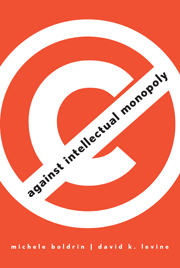Book contents
- Frontmatter
- Contents
- Acknowledgments
- 1 Introduction
- 2 Creation under Competition
- 3 Innovation under Competition
- 4 The Evil of Intellectual Monopoly
- 5 The Devil in Disney
- 6 How Competition Works
- 7 Defenses of Intellectual Monopoly
- 8 Does Intellectual Monopoly Increase Innovation?
- 9 The Pharmaceutical Industry
- 10 The Bad, the Good, and the Ugly
- References
- Index
- Plate Section
3 - Innovation under Competition
Published online by Cambridge University Press: 30 July 2009
- Frontmatter
- Contents
- Acknowledgments
- 1 Introduction
- 2 Creation under Competition
- 3 Innovation under Competition
- 4 The Evil of Intellectual Monopoly
- 5 The Devil in Disney
- 6 How Competition Works
- 7 Defenses of Intellectual Monopoly
- 8 Does Intellectual Monopoly Increase Innovation?
- 9 The Pharmaceutical Industry
- 10 The Bad, the Good, and the Ugly
- References
- Index
- Plate Section
Summary
We have just seen numerous examples showing the frenetic pace of creation in the absence of copyright. Of course, people love to create stories, music, movies – and even news. So, perhaps you agree that copyright is not such a big deal, and even that it is not such a good idea. However, although we may hope to live lives free of boredom in the absence of intellectual monopoly, what about invention, the driving force of economic growth and prosperity? Would we benefit from all of the machines, drugs, and ideas that surround us if not for the beneficent force of patent law? Can we risk the foundation of our prosperity and growth by eliminating patents? In fact, the evidence shows that the invention of marvelous machines, drugs, and ideas does not require the spur of patents. If anything, the evidence shows, it is the other way around: patent protection is not the source of innovation, but rather the unwelcome consequence that, eventually, tames it.
We have already looked at the computer software industry: at its inception and during its most creative decades, the industry was essentially free of patents and made almost no use of copyright protection to prevent entry by competitors. As creativity slowed down, consolidation took place, and a few large monopolists emerged (one in particular), the demand for copyright first and patents later grew.
- Type
- Chapter
- Information
- Against Intellectual Monopoly , pp. 42 - 67Publisher: Cambridge University PressPrint publication year: 2008



